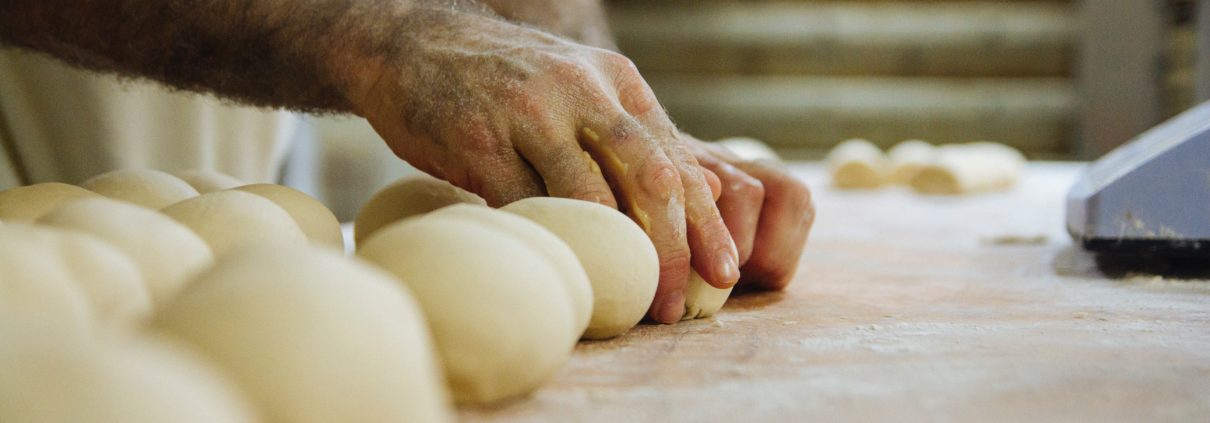The Foundation of Great Pizza Dough (Geeky)
Good pizza starts with good math.
Ok, I’ll admit it. The subject of this post isn’t the most exciting.
But its important.
If you’re serious about making good pizza at home you need to weigh ingredients. And work with Baker’s Percentages.
Let me explain.
Weight is Best
Professional bakers and pizzaiuolos don’t measure ingredients by volume.
Scooping ingredients into a cup is both messy and inaccurate.
Flour, for example, settles. This means that the weight of one cup of sifted flour is different than non sifted.
Then there is the issue of where to measure. Do you measure to the line on your measuring cup? Or just above it? Are the ingredients flush or mounding? It’s never exactly the same.
To accurately measure ingredients, weight is better than volume. Hands down.
Sadly, not all weight systems are the same. Metric (grams) is more precise to work with than Imperial (ounces). Let me show you why.
1 pound (Imperial) = 16 ounces (Imperial) or 16 units of measure per pound
1 pound (Imperial) = 454 grams (Metric) or 454 units of measure per pound
Yes, there are scales which measure in fractions of an ounce. But most don’t.
And then there’s the fact that the entire professional baking world works in Metric. If it’s good enough for them, it should be good for you.
2. The language of dough
Pick up a good pizza or bread book and you will quickly notice a few things. Recipes are called “formulas”. Formulas are written using grams or kilograms. And ingredients are listed with a percentage next to them. This last point might seem strange, but it’s actually the language of bakers. It’s called “Baker’s Percentages”. Yes, not the most creative name, but easy to remember.
What the heck is this and why is it so important?
Pizza dough has relatively few ingredients. In it simplest form flour, water and salt is all you need. Because the ingredient list is short, the relationship of the ingredients to one another is extremely important. Baker’s percentages is a method of writing recipes that describes this relationship.
This is done by listing each ingredient as a percentage of the total weight of flour.
For beginners, this can be confusing to understand.
The cardinal rule for working with Baker’s Percentages is to use the weight of the flour as the benchmark for calculating the formula. NOT the combined weight of the ingredients.
This means flour is always 100% of the formula regardless of the weight.
So let’s say you have a recipe which calls for 1000g of flour, 650g of water and 20g of salt.
Translate this recipe into Baker’s Percentages and this is what the formula looks like:
Flour: 100%
Water: 65%
Salt: 2%
In the example above I’ve made the flour weight 1000g to make the math easy.
To calculate the water percentage divide the weight of the flour (1000g) by the weight of the water (650g). 650/1000 = 65%
Do the same to get the salt percentage. 20/1000 = 2%
Voila!
[If this still seems confusing check out a few more examples at the end of this post.]
Once you start working with Baker’s Percentages you quickly start to see the advantages.
First, its easier to write new dough recipes when you’re thinking about how ingredients relate to each other instead of in isolation. The water to flour percentage, for example, is a such crucial relationship there’s even a term for it: “Dough Hydration”.
Second, Baker’s Percentages allows one to easily scale a recipe up or down and still be sure of having good results.
This means I can develop new dough formulas by testing small batches, but quickly calculate larger production batches when needed.
Let me show you.
Here’s a formula I’m currently working on.
[Since I’m using multiple flours, all of the flours have to add up to 100%.]
High Gluten Flour: 40%
High Extraction Flour: 50%
Whole Wheat Flour: 10%
Water: 65%
Salt: 3%
Yeast: .5%
Oil: 2%
Here’s how I calculate a small test batch formula using 2Kg (2000g) of flour.
High Gluten Flour: 2000 x .40 = 800g
High Extraction Flour: 2000 x .50 = 1000g
Whole Wheat Flour: 2000 x .10 = 200g
Water: 2000 x .65 = 1300g
Salt: 2000 x .03 = 60g
Yeast: 2000 x .005 = 10g
Oil: 2000 x .02 = 40g
When the time comes to make a large production batch, I plug in the new weight of the flour (could be 11Kg, 22Kg or even 44Kg) and then perform the exact math.
Make sense?
Ok, that enough for today. As always, email me your questions.
Additional Baker’s Percentages Examples:
#1
White Flour: 10000g (100%)
Water: 6000g (60%)
Yeast: 30g (.3%)
Salt: 200g (2%)
Malt: 100g (1%)
#2
White Flour: 900g (90%)
Whole Wheat Flour: 100g (10%)
Water: 600g (60%)
Sourdough Starter: 200g (20%)
Yeast: 2g (.2%)
Salt: 20g (2%)
Oil: 15g (1.5%)
Similar Posts:
- Friday Night Sourdough Pizza Formula
- Sourdough Pizza “a taglio” Style
- Tools to Make Great Pizza at Home
- Grilled Pizza: Dough Recipe




